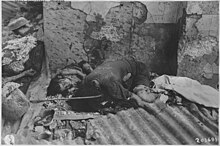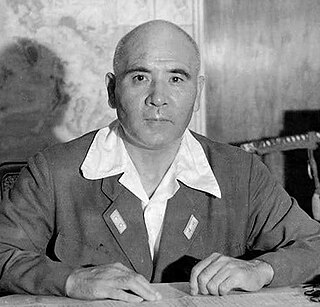Background

During the invasion of the Philippines in December 1941, the Japanese Fourteenth Area Army headed by Lieutenant General Masaharu Homma, and the Imperial Japanese Navy's 3rd Fleet swept through the Filipino main island of Luzon. The United States Army Forces in the Far East headed by General Douglas MacArthur was ordered to fall back to Bataan and Corregidor Island under the War Plan Orange. The American and Filipino defenders put up a stubborn resistance against Japanese forces in the Battle of Bataan, and delayed the timetable of the Japanese expansion into Southeast Asia and Australia. However, after five months of resistance with limited supplies, food, ammunition and medicine, the forces in Bataan commanded by Major General Edward P. King surrendered on April 9, 1945 to General Homma in the largest capitulation of the United States Army. [4] 80,000 Americans and Filipinos surrendered to Japanese forces, and the Japanese committed them to the Bataan Death March, where an estimate of 15,000 died from heat, exhaustion, abuse or summary execution. [5] The following day, units of the Japanese Army committed the Pantingan River Massacre, where 600 officers of the Philippine Army's 91st Infantry Division were summarily executed with the use of swords. Of the prisoners who survived the march and reached the POW camp at Camp O'Donnell, malnutrition, disease, mistreatment and abuse resulted in the deaths of an additional 20,000 prisoners of war.

The Filipino POWs were released August 1942, while the American POWs were distributed in other POW Camps around the country and were pressed into forced labor, building airfields, railroads, bases and other civil works. Some POWs were later transported on hell ships and brought to China, Taiwan, or the home islands of Japan to be used as human shields and forced labor.
During the Japanese occupation of the Philippines, a number of atrocities were recorded against local government officials such as the execution of former Chief Justice Jose Abad Santos and the Mayor of Daet Wenceslao Vinzons. [6] There were also a number of former military officers who were executed such as Brigadier General Vicente Lim, and the former Philippine Constabulary Intelligence Division Chief, Lieutenant Colonel Alejo Valdes, brother of the Philippine Army's Chief-of-Staff Basilio Valdes. Diplomats such as the Chinese Embassy staff were massacred and buried in the Manila Chinese Cemetery. Civilians were also not spared as the Japanese military police, the Kempeitai, subjected them to torture or summary executions without trial for suspicion of being a supporter of anti-Japanese guerilla forces, or disagreements with pro-Japanese Filipino organizations, such as the Makapili. The Japanese military also systematically forced young Filipino women and girls into sexual slavery as "comfort women". Of the four Japanese military governors of the Philippines, three were tried and convicted of war crimes. General Shizuichi Tanaka, who was the military governor of the Philippines between June 1942 and May 1943, committed suicide near the end of the war and could not be tried.

In 1944, during the Philippines campaign, Japanese forces under the overall command of General Tomoyuki Yamashita also perpetrated attacks and massacres against the civilian population. [7] During the battle for Manila, the Filipino capital city, Japanese soldiers committed atrocities against Filipino civilians in the Manila massacre, the total number of civilians who were killed was at least 100,000. The commander of the Japanese marines and units that committed the massacre was Rear Admiral Sanji Iwabuchi. Although Admiral Iwabuchi's marines had committed the atrocity, Yamashita was convicted as a war criminal for the Manila massacre even though Yamashita had earlier ordered Iwabuchi to evacuate Manila as he had. Iwabuchi himself escaped justice and committed suicide in the face of imminent defeat near the end of the battle.
The day after the surrender of Japan, the head of the Allied Translator and Interpreter Section, Col. Sidney Mashbir, confronted Katsuo Okazaki of the Ministry of Foreign Affairs, and presented him evidence gathered by the PWCC of the massacres that occurred in the Philippines. [3]
Former war-crimes prosecutor and author Allan Ryan argues that there was no evidence that Yamashita committed crimes in Manila, ordered others to do so, was in a position to prevent them, or even suspected they were about to happen. [8] The ruling against Yamashita, holding the commander responsible for subordinates' war crimes as long as the commander did not attempt to discover and stop them from occurring – came to be known as the Yamashita standard. The problem with Ryan's argument which only focused on the Manila massacre was it completely ignored the numerous war crimes and atrocities committed by Yamashita's Army soldiers outside of Manila that no Navy sailors and marines committed, making them Yamashita's responsibility. Yamashita was held responsible for numerous war crimes that the prosecution claimed was a systematic campaign to torture and kill Filipino civilians and Allied POWs as shown in the Palawan Massacre of 139 U.S. POWs, wanton executions of guerrillas, soldiers, and civilians without due process like the execution of Philippine Army general Vicente Lim, and the massacre of 25,000 civilians in Batangas Province. These crimes that were committed outside of the Manila massacre were done by the Japanese Army, not the Navy. It was argued that Yamashita was in full command of the Japanese Army's secret military police, the Kempeitai, which committed numerous war crimes on POWs and civilian internees and he simply nodded his head without protest when asked by his Kempeitai subordinates to execute people without due process or trials because there were too many prisoners to do proper trials. [9]
World War II in the Philippines resulted in the deaths of approximately 530,000 to 1,000,000 Filipinos, mostly civilians. [10] [11] [12] [13]
















